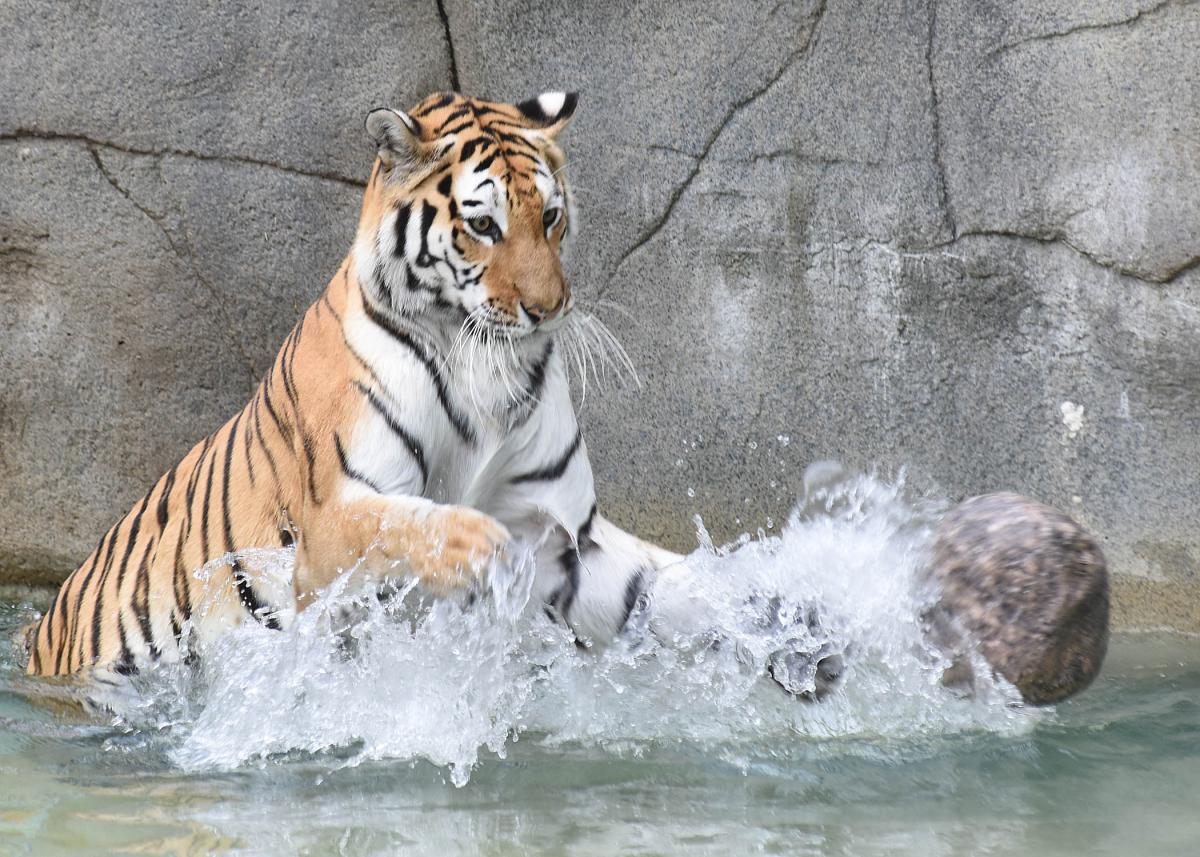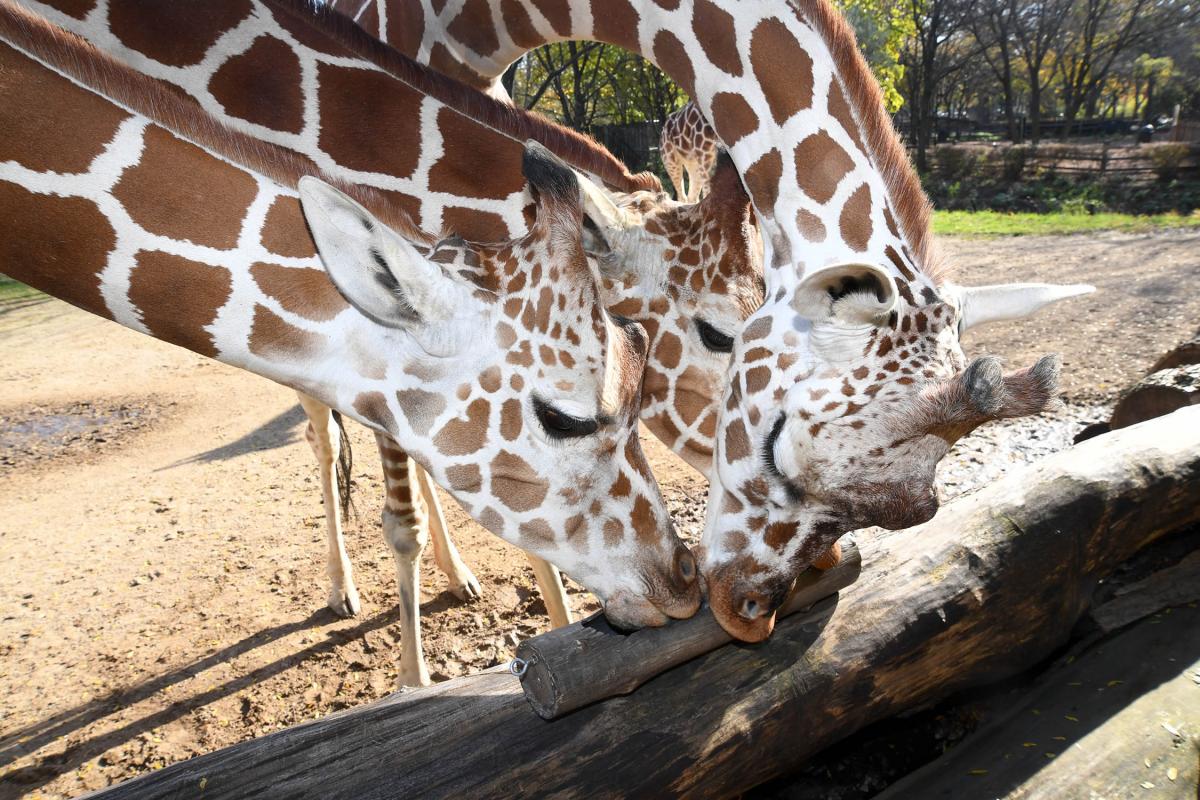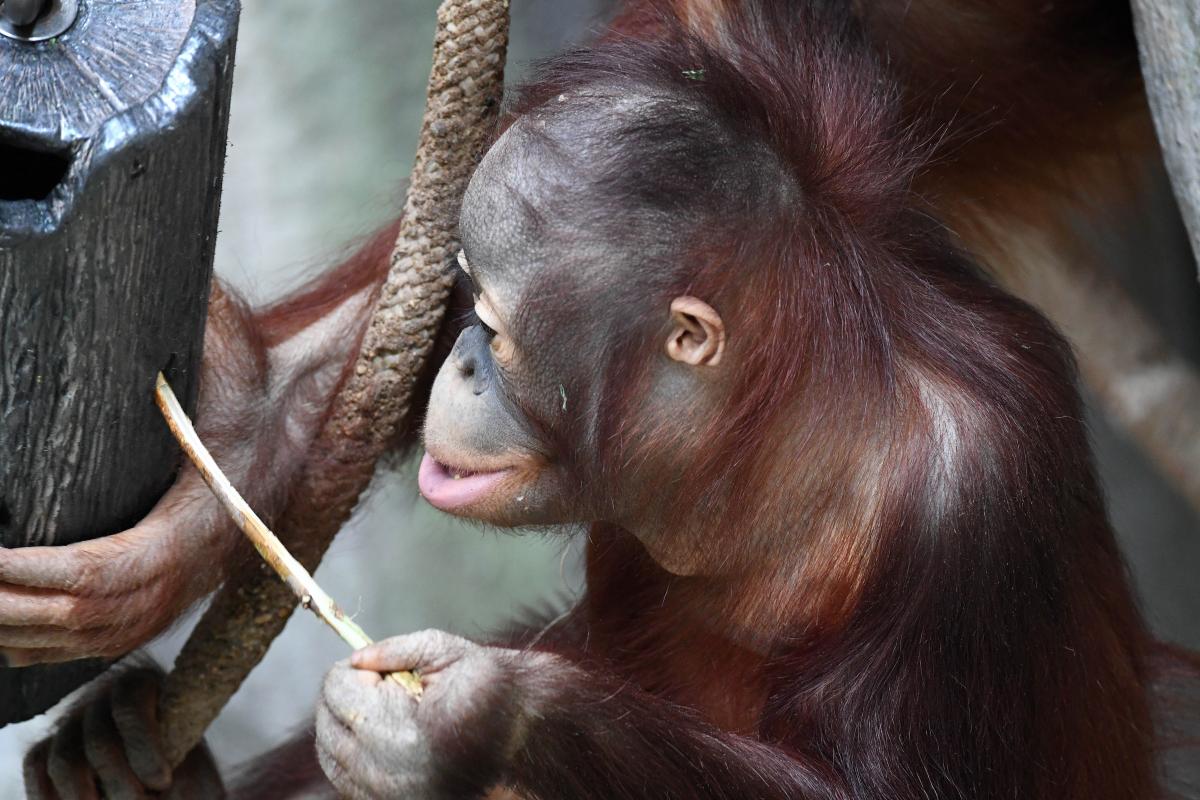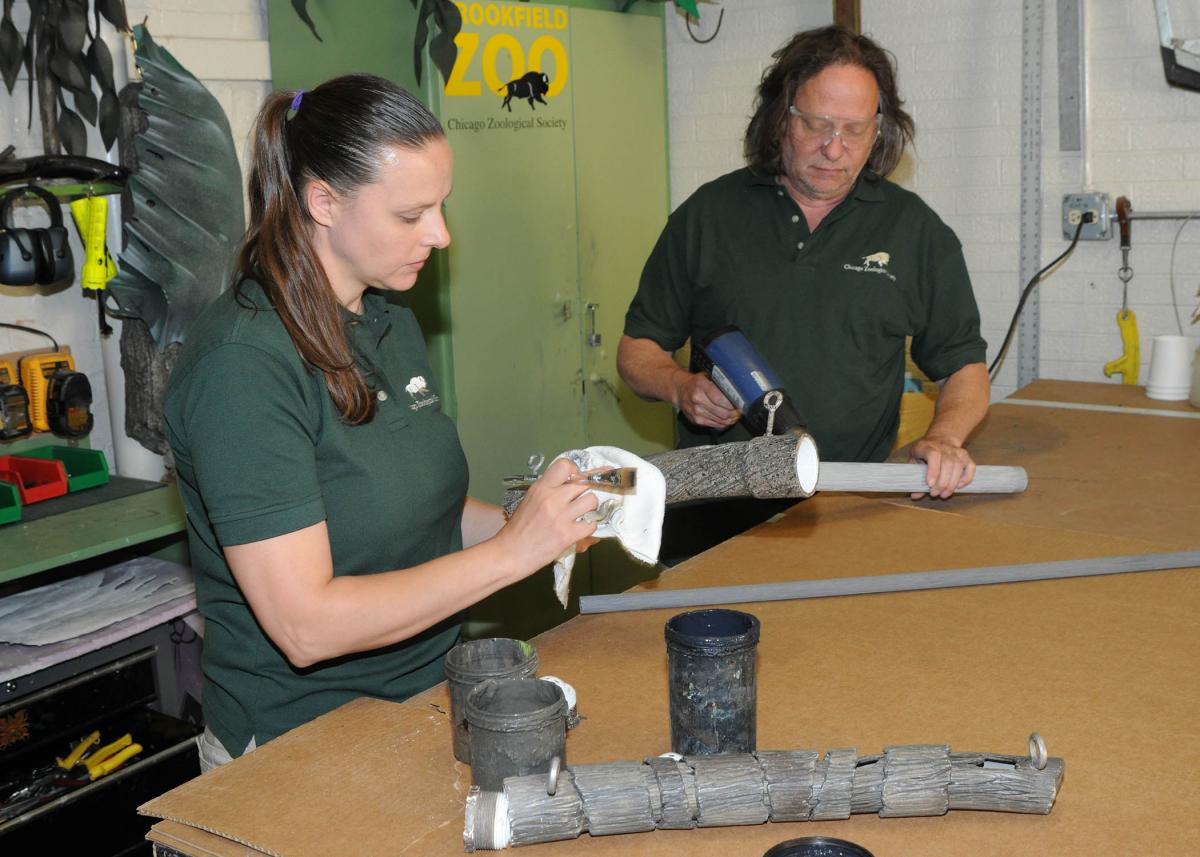Helping ZOO Animals Find the Fun
Animals in captivity are sheltered from many of the dangers they would face in the wild, but are also deprived of the stimulation they would get by fighting to survive. Designers at Chicago’s Brookfield Zoo are working to provide them with challenges that keep them happy and healthy.
Matthew Owens and Sarah Feliciano stand on a walkway at Chicago Zoological Society’s Brookfield ZOO, watching Sophia, an orangutan, cradling her two babies. ‘I call the animals our clients,’ says Owens, ‘and the orangutans are our toughest clients.’ His colleague agrees. ‘They will tear something apart just to show you that they can,’ she says, with a laugh and the smile of a designer who appreciates a challenge, the challenge of designing for animals, to be exact.
Behind the scenes at ZOOs like Brookfield (the first ZOO in the world to receive the American Humane Society’s Humane Certified certification mark) are people like Owens and Feliciano, the ZOO’s senior craftsman and enrichment specialist respectively, who design behavioural challenges for the animals to keep them happy and healthy. Nor is this just a hobby or visitor attraction, but a budding science called environmental enrichment, the design of objects to improve the quality of life of animals living in captivity. Tim Sullivan, Brookfield’s curator of behavioural husbandry, recalls watching Sophia carefully peel a two-inch strip of cardboard from a box one day. ‘I was wondering what she was doing, so I kept looking. She was at it for almost 20 minutes. She then flattened the ends to provide rigidity and used it to reach a favourite item a metre outside of her enclosure.’ She had an idea and created a tool to act upon it. It’s just one example of the animals’ intelligence and why the design of their happiness can’t be left to regular carpenters or toy manufacturers.
Though the farm industry affects billions of animals compared to the relatively small number of animals at ZOOs, ZOOs are easy targets for criticism because while farm industry animals are largely hidden away, the animals in ZOOs are on display for the public to see.
Enrichments are created for Brookfield’s more than 2,000 individual animals in the team’s workshop, whose walls are lined with tools, samples of PVC bark and paw models of different animal species. A giant rubber warthog head adorns the wall. Fake kelp hangs from a shelf. An industrial table is covered in examples from the ‘design portfolio’: tree stands, tunnels, leaf-shaped hammocks, logs for nesting and feeding. There is a ball, designed to look like a rock, whose weighted base makes it roll in unexpected directions, encouraging tigers to be quick and agile as they bat it around. The ‘kelp’ is made from carwash sponge, with pockets that can be loaded with little fish, giving otters something to forage for. Owens explains, ‘The variety and unpredictability of the natural environment is what we are trying to recreate. We don’t want our animals to be couch potatoes.’

It’s a rock that floats? Enrichment is camouflaged as natural objects to keep the environment looking as much like a natural habitat as possible. There are some zoos left who use brightly coloured children’s toys for the animals’ entertainment, but that practice is becoming a remnant of a bygone era. (Photos courtesy of Chicago Zoological Society.)
This attention to the natural requirements and behaviours of animals is relatively new. ‘Animal caretakers for years mostly provided animals with occupying things to do,’ Sullivan says. ‘“Toys” is what they would call them. Staff would use plastic preschool toys, activity boards, cones, buckets or beer kegs.’ Sullivan’s first objection to that approach concerns the institutions’ educational function: ‘Zoos combine entertainment with a conservation mission. We get people in to learn about animals and their habitats, to become aware of their own role in conservation. When you design an entire environment to represent a natural habitat, you want the toys to match the environment.’ More important, however, was the failure of those foreign objects to promote healthy natural behaviour.
You seem to enjoy a good story
Sign up to our infrequent mailing to get more stories directly to your mailbox.According to Sullivan, Hal Markowitz was a key figure in making environmental enrichment a science. He created changes in ZOO environments in the seventies and eighties that allowed animals to behave as they would in the wild. Like most people with radical ideas, Markowitz encountered a lot of headwind. ‘Zoos were concerned he was taking the nature out of animals,’ says Sullivan. ‘It took a few decades for people to change their minds. Enrichment as we now define it is designed to encourage foraging, hunting and cognitive ability and allow animals to work their minds as well as their bodies. Some items are designed for play, others for food and all are intended to increase welfare.’

In the wild, giraffes forage on leaves for over 13 hours a day. Zoos cannot provide unlimited supplies of trees and therefore come up with alternative ways to encourage the natural behaviour. This ‘giraffe tongue obstacle course’, in the shape of a log, helps giraffes practise the natural dexterity of their tongues and keeps them engaged with the food longer, as they would be in the wild. (Photos courtesy of Chicago Zoological Society.)
‘Take the giraffes for example,’ he continues. ‘They get three cups of pellet grains per day, super rich in nutrients. With their 18-inch tongues, it’s three licks and they are done. Giraffes in the wild forage leaves for 13 hours a day. We want them to have all the nutrients, so how do we occupy them?’ Without the stimulation provided by their natural environment, the giraffes instinctively began to lick the walls of their enclosure, ingesting bits of paint, standing with their backs to visitors, and increasing maintenance costs. ‘We had to repaint the walls of the giraffe house every year,’ Owens recalls.
He shows the solution that they designed: a tree-trunk with a ‘tongue obstacle course’ designed to slow down the eating process and increase the effort required, providing a challenge for the animals by mimicking a situation they would face in the wild. ‘In acacia trees there are thorns, and giraffes’ tongues have to be very agile in getting to the leaves. We created this for the tongue to gain a dexterity that is otherwise not attained.’ It quickly paid off. ‘The benefits are numerous: the animals are engaged, stimulated physically and emotionally, and the licking of the walls stopped, so we don’t have to repaint the murals. For visitors it is more fun too.’
The giraffe feeder serves as an example of Owens and Feliciano’s design process, which always begins with the behaviour they want to encourage. Feliciano explains: ‘We use a briefing form and discuss with the animal care specialists what the animal’s needs are.’ ‘Several of our animal care specialists have master’s degrees, and they are basing their decisions on science,’ adds Owens. ‘Annually, the teams look at each species and set behavioural norms for the animal. Once we know the potential triggers for a behaviour, we design the enrichment.’

The design of the enrichment tools comes with many challenges: objects have to be designed in such a way that the animals cannot hurt themselves or use the objects as projectiles (orangutans have a great throwing arm). The tools are designed to create challenging tasks for the animals that mimic those in the wild. Orangutans are tool users who look for clever ways to get to the prize: ants, honey or other snacks. (Photos courtesy of Chicago Zoological Society.)
There are multiple factors to consider. The climate in Chicago is such that most objects need to be weatherproof. Of course, they also need to be safe. ‘We send new materials we use to the veterinary staff to make sure the materials are non-toxic,’ says Feliciano. ‘And the managers and animal care staff check the enrichments for safety and will supervise when they are used for the first time.’ No detail is too small to consider, as Owens explains: ‘When a design can be broken into pieces, are animals able to swallow the smallest pieces? Can they put their hand in but not their head? There might be animals of different ages playing with it. Can a young animal get stuck? We have to babyproof the materials too.’
Many of the animals have a keen sense of smell that also needs to be stimulated, and so cinnamon, camel hair and old snake skins find their way into the workshop, and the ZOO also collects unwanted bottles of perfume. The lions in particular love Calvin Klein’s Obsession. Sullivan says, ‘They just love rolling around with it. We’ve let the company know.’
Not all design requirements are dictated by the animals. The care specialists also have their needs, since they are the ones who maintain the enrichment items in the animals’ quarters. ‘Some of them are short, some are tall and strong. How do they hang the device up in a tree, how do they clean it?’ Once all concerns are addressed, the user (read: the animal) gets to test a prototype. ‘It is quite typical that the animals outsmart us,’ Owens says. ‘They figure it out quickly, and then we have to go back in and make it more interesting again.’

Feliciano and Owens sculpt branch-like objects from PVC pipe, moulding, carving and painting it to be almost indistinguishable from a real tree, yet easy to clean, hygienic and strong. Owens: ‘Contractors leave large amounts of leftover PVC pipes at building sites and we are on it like dung beetles.’ The materials are cheap, the biggest cost in the design is the labour. The giraffe feeding log takes about four hours to create. (Photo courtesy of Chicago Zoological Society.)
The staff monitor each enrichment to make sure it is doing what the team intended it to do, iterating until it works. ‘For instance we might have 20 squirrel monkeys that we design for,’ says Sullivan. ‘There is a bell curve: most animals in the group respond in a positive way but not all of them will. So we then design a solution for the outliers.’
Like humans, animals have individual tastes, so the design process is customised for each animal. One giraffe might like leaves while another doesn’t. Or a particular animal has a very specific behavioural challenge. Feliciano gives an example: ‘We have a geriatric gorilla. This is becoming normal because animals in professional care live longer than in the wild. This gorilla has arthritis and needs a device that helps him increase the range of motion of his arms. So we created several puzzle feeders and installed them at a particular height that encourages him to lift his arms and stretch, which keeps his shoulder joints supple.’
It’s no surprise that food is often involved in an effective intervention. According to Feliciano, food is a great motivator for behaviour, and therefore many enrichments are designed around it. They jokingly divide the animals into those who like peanut butter and those who don’t. Feliciano says, ‘Those who don’t are harder to please.’
Because each item is customised to meet a particular animal’s needs there are no businesses that sell animal enrichment products, no online stores or mail-order companies. ‘A lot of ZOOs rely on volunteers to make these things,’ says Sullivan. ‘We are unique in having dedicated staff that does this. In other ZOOs, there is a carpenter that repairs fences and builds enrichment items as well.’ Feliciano and Owens are widely regarded as at the forefront of their field, and their work attracts attention. For instance, bear keepers across the country are showing interest in the rolling ball disguised as a rock. The team doesn’t have much time to market their work outside, however, since they are already handling around 260 work orders a year. Instead they prefer to share their knowledge.
There is a budding scene around exchanging ideas for enrichment, such as ‘The Shape of Enrichment’, a website, newsletter and biennial event for animal care professionals. ‘We see that Disney parks are copying some of our materials,’ says Owens, ‘but we don’t see it as a problem. What is good for animals is good for us all.’
The staff started asking us to make the enrichment items a little more natural and we thought, rather than just redecorate it, let’s redesign it.’ A big challenge for an artist is to make a living with your talent.
In spite of everything that the enrichment team does to care for its ‘clients’, the question remains: is it all a sticking plaster to cover the pain of animals living in captivity, something to assuage the consciences of institutions and the public?
Sullivan puts the question into perspective: ‘Wild animals are rarely brought into American ZOOs due to species conservation regulations and the ZOOs’ desire to have self-sustaining populations. Almost all of Brookfield Zoo’s inhabitants are third-, fourth- or fifth-generation, born and raised in professional care. If we could go back in time one hundred years and ask, “Should we create ZOOs?” maybe we wouldn’t have. But the animals are here now and play a vital role in connecting our guests with nature. Most of these animals can’t be reintroduced to the wild, and we do the best job we can at keeping the animals happy and healthy and promoting science and environmental protection.’
Dr Joseph Barber, research fellow at Disney’s Animal Kingdom in the USA, would approach the question from an even wider perspective: ‘Enrichment is a way to maximise welfare in captive environments, whether that is a ZOO environment, a farm or a lab.’ Thus animal welfare is a subject relevant to anyone who eats meat, dairy products or eggs, wears leather, fur or wool, uses animal-tested pharmaceuticals, owns a pet or visits a ZOO.
In terms of promoting the welfare of animals, he believes there are good ZOOs and bad ZOOs. ‘And at a good ZOO, there are good exhibits and bad exhibits. And not all education is good education. In an immersive exhibition with a lion standing against a glass pane, and a child on the other side, and the lion trying to get through the glass to get to the child, I’m not sure what kind of education that provides. I would rather have people be amazed by lions hunting and killing and doing what lions do. Instead the child sees how we can control animals. So not all ZOO experiences are necessarily teaching people the right lessons.’
For Sullivan, Brookfield’s more than two million visitors a year are an opportunity to teach the right lessons. ‘We have kids who come here from underprivileged communities who have never seen or touched a dirt patch before. Who will most likely never see these animals in the wild…’ Owens agrees that enrichment increases the chances that those visitors will connect with the animals. ‘You will fall in love with a gorilla that is goofing around, not one that is sleeping all day. The ZOO needs people to fall in love with animals. We need people to care about the animals so they change their behaviour regarding conservation and the environment, make them little conservation leaders in their own way. Unfortunately, humans are the toughest species to change.’

